Sexual Harassment in the Workplace: Examining Feminist Theories
VerifiedAdded on 2021/04/24
|8
|1544
|225
Essay
AI Summary
This essay delves into the critical issue of sexual harassment in the workplace, providing a comprehensive analysis through the lens of feminist theories. It begins by defining sexual harassment and presenting relevant statistics, highlighting the growing prevalence of this issue in Australia. The essay then explores two key theoretical frameworks: Marxist feminism and radical feminism. Marxist feminism is examined to understand how capitalism and power dynamics contribute to gender inequality and female oppression, while radical feminism is analyzed to understand how patriarchal structures perpetuate sexual harassment. The essay uses the provided data and statistics to support its arguments, concluding with a discussion on how these theories can inform strategies to reduce and prevent sexual harassment, advocating for gender equality and societal changes. The document is contributed by a student and available on Desklib, a platform that provides AI-powered study tools and resources for students.
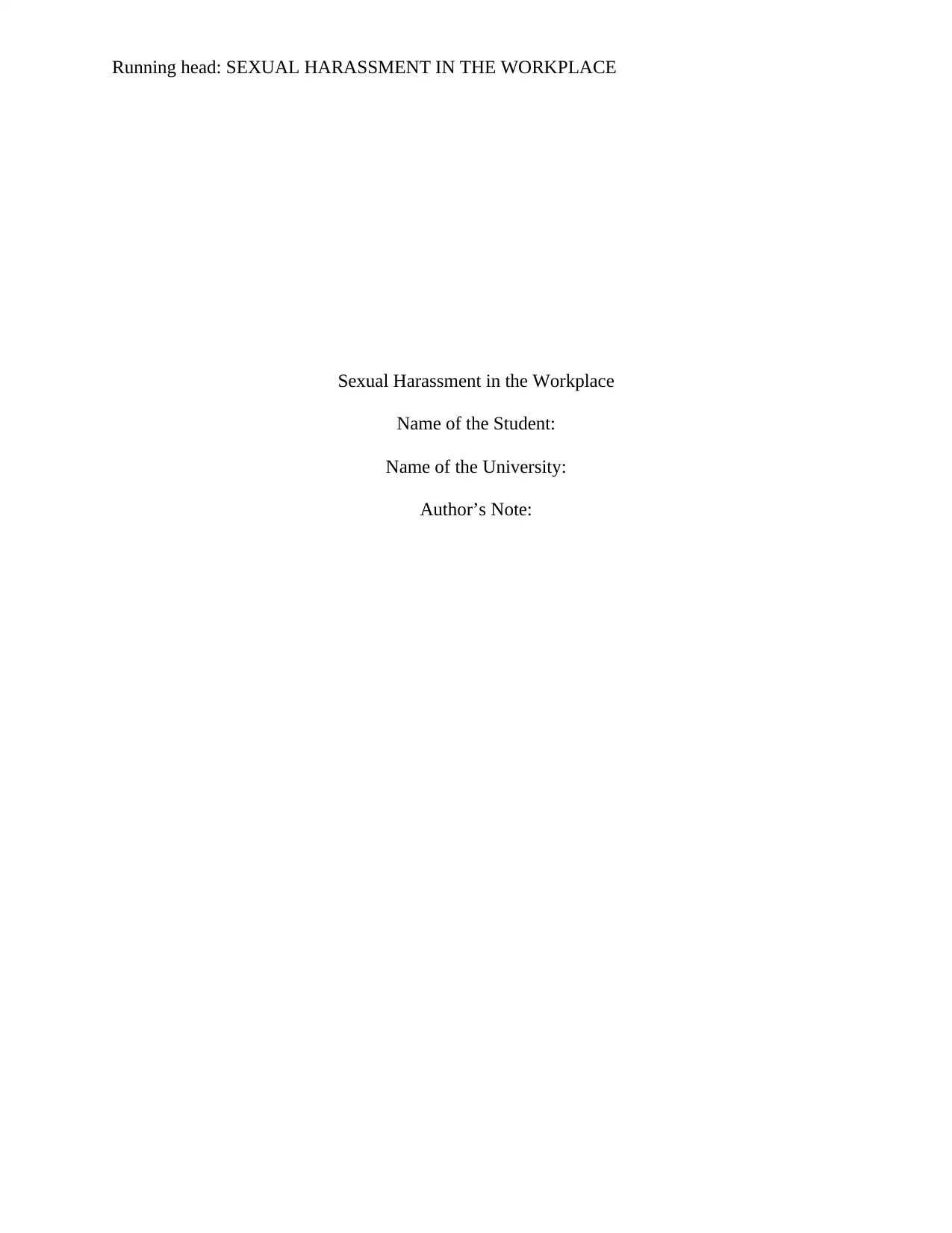
Running head: SEXUAL HARASSMENT IN THE WORKPLACE
Sexual Harassment in the Workplace
Name of the Student:
Name of the University:
Author’s Note:
Sexual Harassment in the Workplace
Name of the Student:
Name of the University:
Author’s Note:
Paraphrase This Document
Need a fresh take? Get an instant paraphrase of this document with our AI Paraphraser

SEXUAL HARASSMENT IN THE WORKPLACE 1
1.0 Introduction
Sexual harassment can be considered as the uninvited sexual advance or any undesirable
request in favor of sexual activity that makes a person feel insulted or offended (Sahgal and
Dang 2017). Some of the most common sexual harassing behavior include unwelcome staring
and touching, passing jokes or comments, uninvited dating, request for having sex,
uncomfortable questions about a person’s private body, sexual physical contact or even explicit
sexual mails or SMS (Charlesworth 2017).
The Australian Human Rights Commission (AHRC) found in 2012 that one-third of
women and one-sixth of men reported sexual harassment in workplace in past four years.
Moreover, the sexual harassment complaints have increased to 247 in 2016 from 186 in 2007
(Alcorn 2017). In the year 2016, according to Australian Federal Police, 20% of men and 46% of
women employees were sexually harassed (Alcorn 2017). The statistics is provided in figure 1
from where it can be observed that the sexual harassment activities are growing at a steady rate.
Sexual harassment in workplace mostly impacts on paying attention while working and
even the victims skip group meetings or avoid being social (Sahgal and Dang 2017). Moreover,
the emotional well-being of an individual is jeopardized, which finally leads to mental and
physical health issues associated with loss of appetite, sleep disturbances or even weight
fluctuations (Sahgal and Dang 2017).
1.0 Introduction
Sexual harassment can be considered as the uninvited sexual advance or any undesirable
request in favor of sexual activity that makes a person feel insulted or offended (Sahgal and
Dang 2017). Some of the most common sexual harassing behavior include unwelcome staring
and touching, passing jokes or comments, uninvited dating, request for having sex,
uncomfortable questions about a person’s private body, sexual physical contact or even explicit
sexual mails or SMS (Charlesworth 2017).
The Australian Human Rights Commission (AHRC) found in 2012 that one-third of
women and one-sixth of men reported sexual harassment in workplace in past four years.
Moreover, the sexual harassment complaints have increased to 247 in 2016 from 186 in 2007
(Alcorn 2017). In the year 2016, according to Australian Federal Police, 20% of men and 46% of
women employees were sexually harassed (Alcorn 2017). The statistics is provided in figure 1
from where it can be observed that the sexual harassment activities are growing at a steady rate.
Sexual harassment in workplace mostly impacts on paying attention while working and
even the victims skip group meetings or avoid being social (Sahgal and Dang 2017). Moreover,
the emotional well-being of an individual is jeopardized, which finally leads to mental and
physical health issues associated with loss of appetite, sleep disturbances or even weight
fluctuations (Sahgal and Dang 2017).
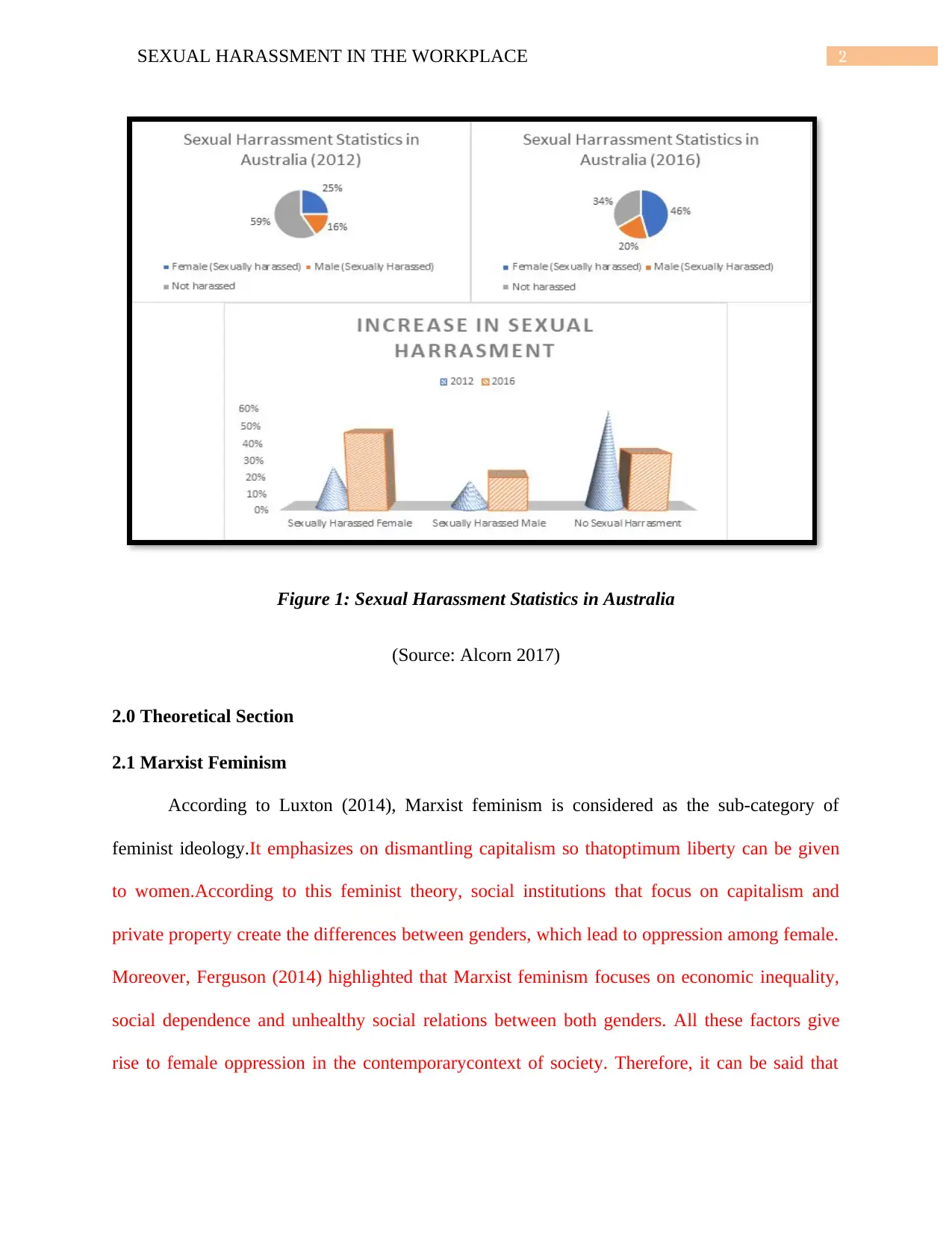
SEXUAL HARASSMENT IN THE WORKPLACE 2
Figure 1: Sexual Harassment Statistics in Australia
(Source: Alcorn 2017)
2.0 Theoretical Section
2.1 Marxist Feminism
According to Luxton (2014), Marxist feminism is considered as the sub-category of
feminist ideology.It emphasizes on dismantling capitalism so thatoptimum liberty can be given
to women.According to this feminist theory, social institutions that focus on capitalism and
private property create the differences between genders, which lead to oppression among female.
Moreover, Ferguson (2014) highlighted that Marxist feminism focuses on economic inequality,
social dependence and unhealthy social relations between both genders. All these factors give
rise to female oppression in the contemporarycontext of society. Therefore, it can be said that
Figure 1: Sexual Harassment Statistics in Australia
(Source: Alcorn 2017)
2.0 Theoretical Section
2.1 Marxist Feminism
According to Luxton (2014), Marxist feminism is considered as the sub-category of
feminist ideology.It emphasizes on dismantling capitalism so thatoptimum liberty can be given
to women.According to this feminist theory, social institutions that focus on capitalism and
private property create the differences between genders, which lead to oppression among female.
Moreover, Ferguson (2014) highlighted that Marxist feminism focuses on economic inequality,
social dependence and unhealthy social relations between both genders. All these factors give
rise to female oppression in the contemporarycontext of society. Therefore, it can be said that
⊘ This is a preview!⊘
Do you want full access?
Subscribe today to unlock all pages.

Trusted by 1+ million students worldwide
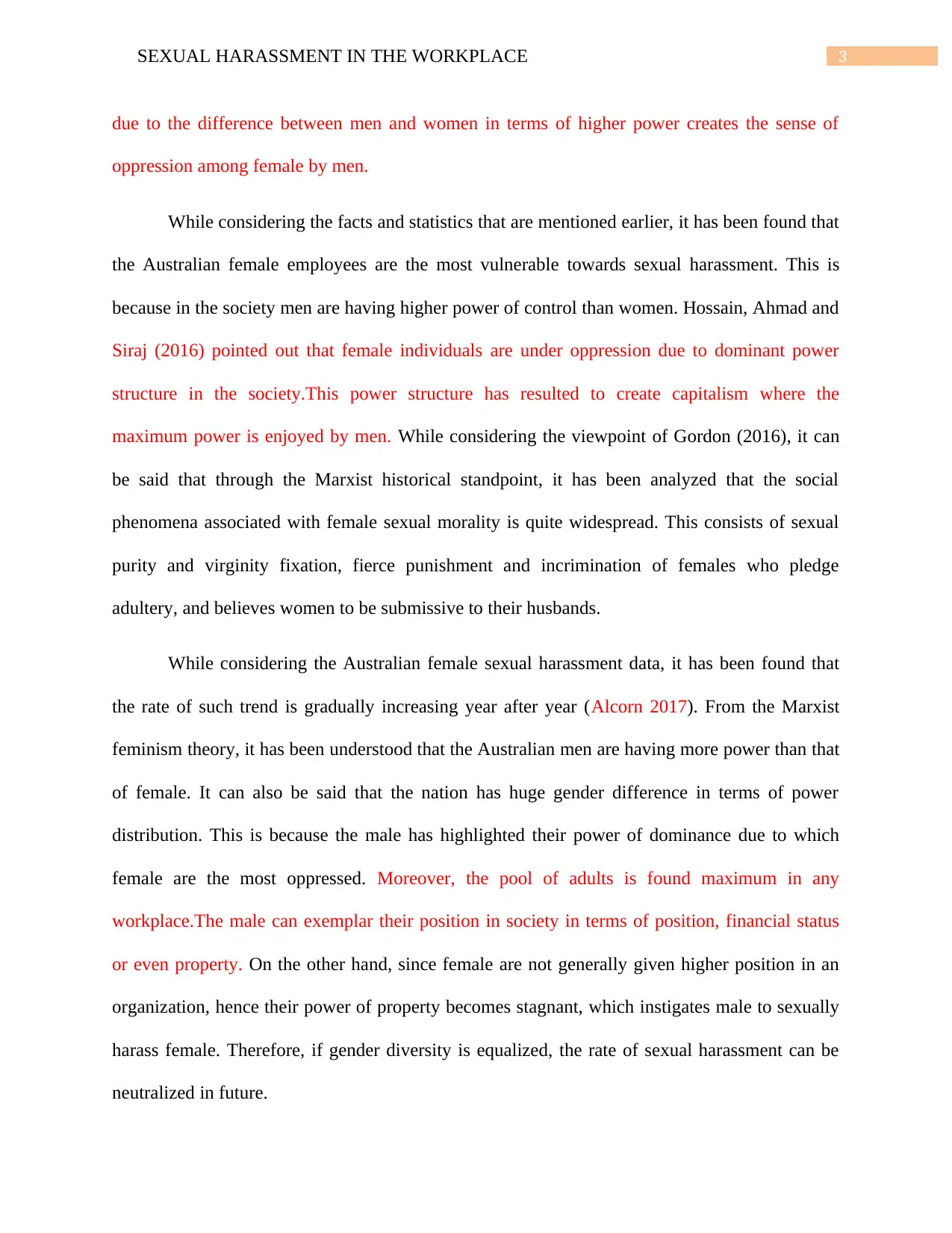
SEXUAL HARASSMENT IN THE WORKPLACE 3
due to the difference between men and women in terms of higher power creates the sense of
oppression among female by men.
While considering the facts and statistics that are mentioned earlier, it has been found that
the Australian female employees are the most vulnerable towards sexual harassment. This is
because in the society men are having higher power of control than women. Hossain, Ahmad and
Siraj (2016) pointed out that female individuals are under oppression due to dominant power
structure in the society.This power structure has resulted to create capitalism where the
maximum power is enjoyed by men. While considering the viewpoint of Gordon (2016), it can
be said that through the Marxist historical standpoint, it has been analyzed that the social
phenomena associated with female sexual morality is quite widespread. This consists of sexual
purity and virginity fixation, fierce punishment and incrimination of females who pledge
adultery, and believes women to be submissive to their husbands.
While considering the Australian female sexual harassment data, it has been found that
the rate of such trend is gradually increasing year after year (Alcorn 2017). From the Marxist
feminism theory, it has been understood that the Australian men are having more power than that
of female. It can also be said that the nation has huge gender difference in terms of power
distribution. This is because the male has highlighted their power of dominance due to which
female are the most oppressed. Moreover, the pool of adults is found maximum in any
workplace.The male can exemplar their position in society in terms of position, financial status
or even property. On the other hand, since female are not generally given higher position in an
organization, hence their power of property becomes stagnant, which instigates male to sexually
harass female. Therefore, if gender diversity is equalized, the rate of sexual harassment can be
neutralized in future.
due to the difference between men and women in terms of higher power creates the sense of
oppression among female by men.
While considering the facts and statistics that are mentioned earlier, it has been found that
the Australian female employees are the most vulnerable towards sexual harassment. This is
because in the society men are having higher power of control than women. Hossain, Ahmad and
Siraj (2016) pointed out that female individuals are under oppression due to dominant power
structure in the society.This power structure has resulted to create capitalism where the
maximum power is enjoyed by men. While considering the viewpoint of Gordon (2016), it can
be said that through the Marxist historical standpoint, it has been analyzed that the social
phenomena associated with female sexual morality is quite widespread. This consists of sexual
purity and virginity fixation, fierce punishment and incrimination of females who pledge
adultery, and believes women to be submissive to their husbands.
While considering the Australian female sexual harassment data, it has been found that
the rate of such trend is gradually increasing year after year (Alcorn 2017). From the Marxist
feminism theory, it has been understood that the Australian men are having more power than that
of female. It can also be said that the nation has huge gender difference in terms of power
distribution. This is because the male has highlighted their power of dominance due to which
female are the most oppressed. Moreover, the pool of adults is found maximum in any
workplace.The male can exemplar their position in society in terms of position, financial status
or even property. On the other hand, since female are not generally given higher position in an
organization, hence their power of property becomes stagnant, which instigates male to sexually
harass female. Therefore, if gender diversity is equalized, the rate of sexual harassment can be
neutralized in future.
Paraphrase This Document
Need a fresh take? Get an instant paraphrase of this document with our AI Paraphraser
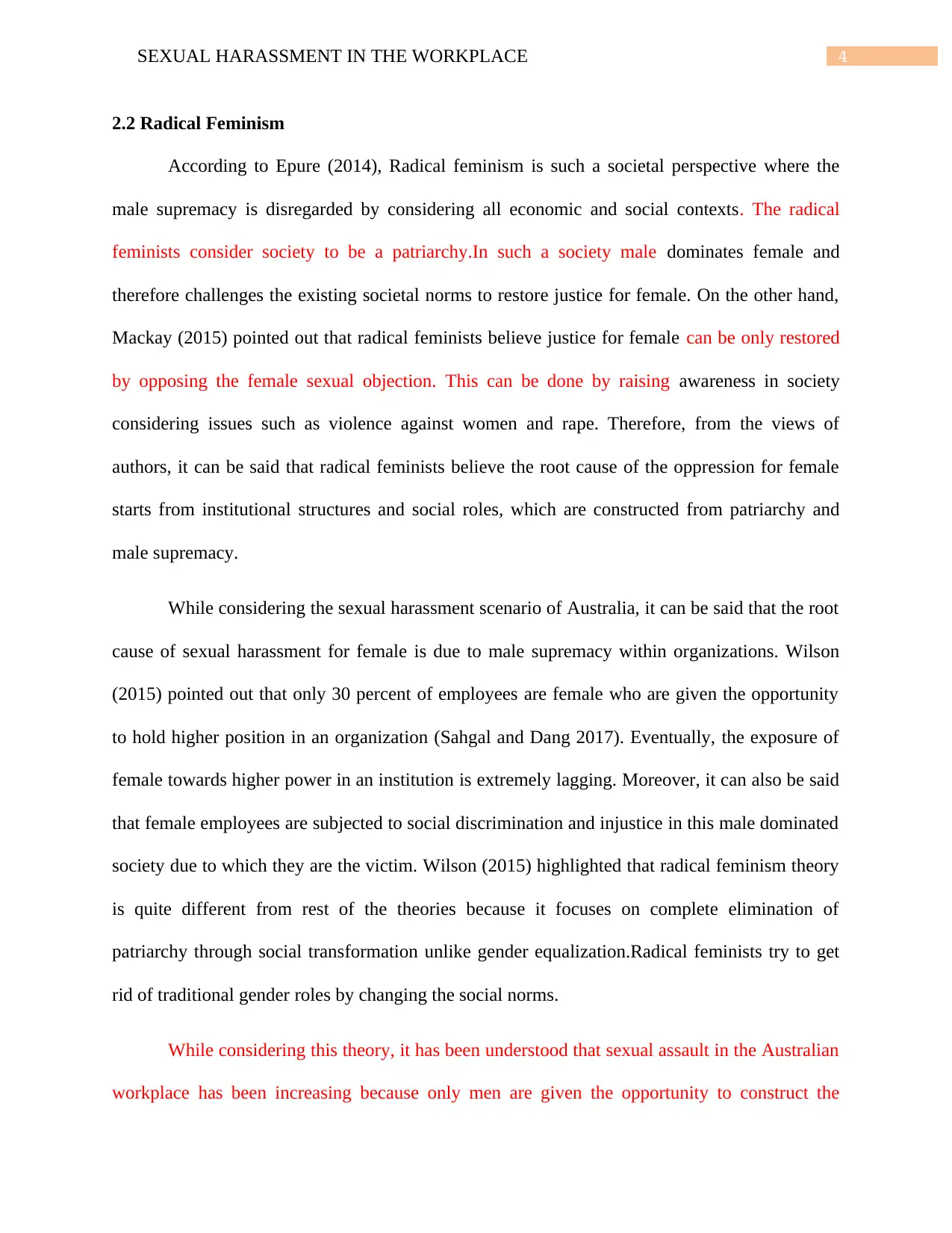
SEXUAL HARASSMENT IN THE WORKPLACE 4
2.2 Radical Feminism
According to Epure (2014), Radical feminism is such a societal perspective where the
male supremacy is disregarded by considering all economic and social contexts. The radical
feminists consider society to be a patriarchy.In such a society male dominates female and
therefore challenges the existing societal norms to restore justice for female. On the other hand,
Mackay (2015) pointed out that radical feminists believe justice for female can be only restored
by opposing the female sexual objection. This can be done by raising awareness in society
considering issues such as violence against women and rape. Therefore, from the views of
authors, it can be said that radical feminists believe the root cause of the oppression for female
starts from institutional structures and social roles, which are constructed from patriarchy and
male supremacy.
While considering the sexual harassment scenario of Australia, it can be said that the root
cause of sexual harassment for female is due to male supremacy within organizations. Wilson
(2015) pointed out that only 30 percent of employees are female who are given the opportunity
to hold higher position in an organization (Sahgal and Dang 2017). Eventually, the exposure of
female towards higher power in an institution is extremely lagging. Moreover, it can also be said
that female employees are subjected to social discrimination and injustice in this male dominated
society due to which they are the victim. Wilson (2015) highlighted that radical feminism theory
is quite different from rest of the theories because it focuses on complete elimination of
patriarchy through social transformation unlike gender equalization.Radical feminists try to get
rid of traditional gender roles by changing the social norms.
While considering this theory, it has been understood that sexual assault in the Australian
workplace has been increasing because only men are given the opportunity to construct the
2.2 Radical Feminism
According to Epure (2014), Radical feminism is such a societal perspective where the
male supremacy is disregarded by considering all economic and social contexts. The radical
feminists consider society to be a patriarchy.In such a society male dominates female and
therefore challenges the existing societal norms to restore justice for female. On the other hand,
Mackay (2015) pointed out that radical feminists believe justice for female can be only restored
by opposing the female sexual objection. This can be done by raising awareness in society
considering issues such as violence against women and rape. Therefore, from the views of
authors, it can be said that radical feminists believe the root cause of the oppression for female
starts from institutional structures and social roles, which are constructed from patriarchy and
male supremacy.
While considering the sexual harassment scenario of Australia, it can be said that the root
cause of sexual harassment for female is due to male supremacy within organizations. Wilson
(2015) pointed out that only 30 percent of employees are female who are given the opportunity
to hold higher position in an organization (Sahgal and Dang 2017). Eventually, the exposure of
female towards higher power in an institution is extremely lagging. Moreover, it can also be said
that female employees are subjected to social discrimination and injustice in this male dominated
society due to which they are the victim. Wilson (2015) highlighted that radical feminism theory
is quite different from rest of the theories because it focuses on complete elimination of
patriarchy through social transformation unlike gender equalization.Radical feminists try to get
rid of traditional gender roles by changing the social norms.
While considering this theory, it has been understood that sexual assault in the Australian
workplace has been increasing because only men are given the opportunity to construct the
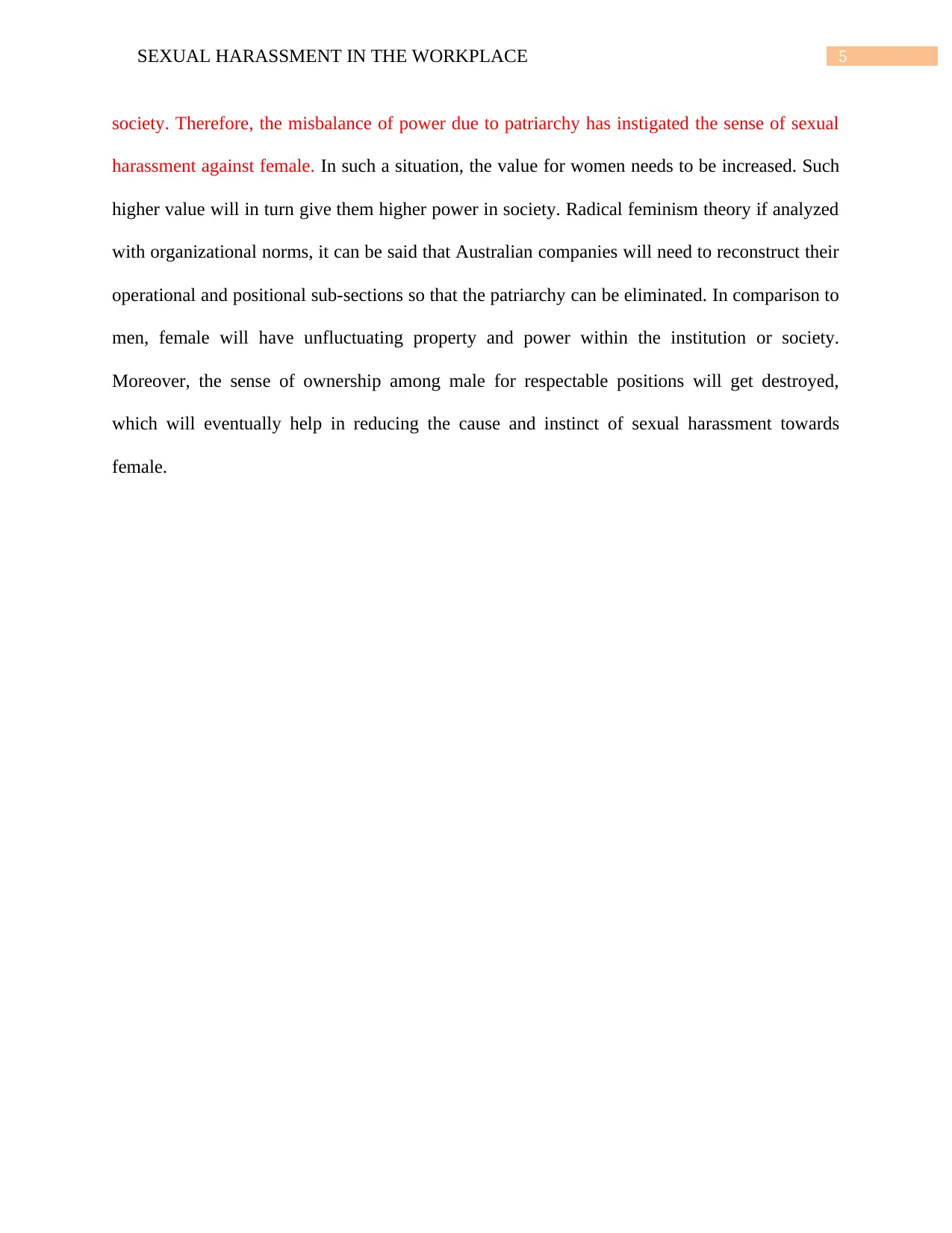
SEXUAL HARASSMENT IN THE WORKPLACE 5
society. Therefore, the misbalance of power due to patriarchy has instigated the sense of sexual
harassment against female. In such a situation, the value for women needs to be increased. Such
higher value will in turn give them higher power in society. Radical feminism theory if analyzed
with organizational norms, it can be said that Australian companies will need to reconstruct their
operational and positional sub-sections so that the patriarchy can be eliminated. In comparison to
men, female will have unfluctuating property and power within the institution or society.
Moreover, the sense of ownership among male for respectable positions will get destroyed,
which will eventually help in reducing the cause and instinct of sexual harassment towards
female.
society. Therefore, the misbalance of power due to patriarchy has instigated the sense of sexual
harassment against female. In such a situation, the value for women needs to be increased. Such
higher value will in turn give them higher power in society. Radical feminism theory if analyzed
with organizational norms, it can be said that Australian companies will need to reconstruct their
operational and positional sub-sections so that the patriarchy can be eliminated. In comparison to
men, female will have unfluctuating property and power within the institution or society.
Moreover, the sense of ownership among male for respectable positions will get destroyed,
which will eventually help in reducing the cause and instinct of sexual harassment towards
female.
⊘ This is a preview!⊘
Do you want full access?
Subscribe today to unlock all pages.

Trusted by 1+ million students worldwide
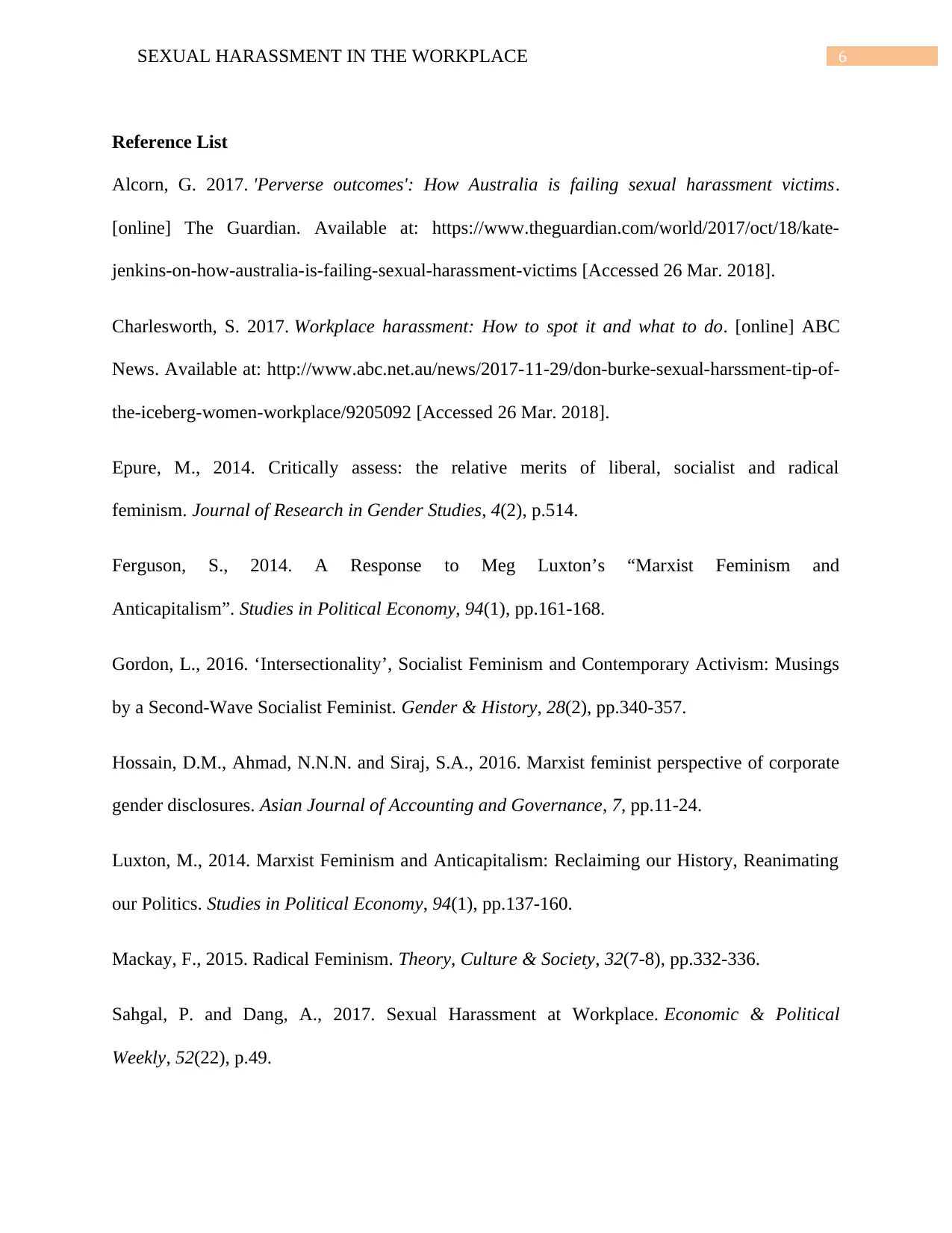
SEXUAL HARASSMENT IN THE WORKPLACE 6
Reference List
Alcorn, G. 2017. 'Perverse outcomes': How Australia is failing sexual harassment victims.
[online] The Guardian. Available at: https://www.theguardian.com/world/2017/oct/18/kate-
jenkins-on-how-australia-is-failing-sexual-harassment-victims [Accessed 26 Mar. 2018].
Charlesworth, S. 2017. Workplace harassment: How to spot it and what to do. [online] ABC
News. Available at: http://www.abc.net.au/news/2017-11-29/don-burke-sexual-harssment-tip-of-
the-iceberg-women-workplace/9205092 [Accessed 26 Mar. 2018].
Epure, M., 2014. Critically assess: the relative merits of liberal, socialist and radical
feminism. Journal of Research in Gender Studies, 4(2), p.514.
Ferguson, S., 2014. A Response to Meg Luxton’s “Marxist Feminism and
Anticapitalism”. Studies in Political Economy, 94(1), pp.161-168.
Gordon, L., 2016. ‘Intersectionality’, Socialist Feminism and Contemporary Activism: Musings
by a Second‐Wave Socialist Feminist. Gender & History, 28(2), pp.340-357.
Hossain, D.M., Ahmad, N.N.N. and Siraj, S.A., 2016. Marxist feminist perspective of corporate
gender disclosures. Asian Journal of Accounting and Governance, 7, pp.11-24.
Luxton, M., 2014. Marxist Feminism and Anticapitalism: Reclaiming our History, Reanimating
our Politics. Studies in Political Economy, 94(1), pp.137-160.
Mackay, F., 2015. Radical Feminism. Theory, Culture & Society, 32(7-8), pp.332-336.
Sahgal, P. and Dang, A., 2017. Sexual Harassment at Workplace. Economic & Political
Weekly, 52(22), p.49.
Reference List
Alcorn, G. 2017. 'Perverse outcomes': How Australia is failing sexual harassment victims.
[online] The Guardian. Available at: https://www.theguardian.com/world/2017/oct/18/kate-
jenkins-on-how-australia-is-failing-sexual-harassment-victims [Accessed 26 Mar. 2018].
Charlesworth, S. 2017. Workplace harassment: How to spot it and what to do. [online] ABC
News. Available at: http://www.abc.net.au/news/2017-11-29/don-burke-sexual-harssment-tip-of-
the-iceberg-women-workplace/9205092 [Accessed 26 Mar. 2018].
Epure, M., 2014. Critically assess: the relative merits of liberal, socialist and radical
feminism. Journal of Research in Gender Studies, 4(2), p.514.
Ferguson, S., 2014. A Response to Meg Luxton’s “Marxist Feminism and
Anticapitalism”. Studies in Political Economy, 94(1), pp.161-168.
Gordon, L., 2016. ‘Intersectionality’, Socialist Feminism and Contemporary Activism: Musings
by a Second‐Wave Socialist Feminist. Gender & History, 28(2), pp.340-357.
Hossain, D.M., Ahmad, N.N.N. and Siraj, S.A., 2016. Marxist feminist perspective of corporate
gender disclosures. Asian Journal of Accounting and Governance, 7, pp.11-24.
Luxton, M., 2014. Marxist Feminism and Anticapitalism: Reclaiming our History, Reanimating
our Politics. Studies in Political Economy, 94(1), pp.137-160.
Mackay, F., 2015. Radical Feminism. Theory, Culture & Society, 32(7-8), pp.332-336.
Sahgal, P. and Dang, A., 2017. Sexual Harassment at Workplace. Economic & Political
Weekly, 52(22), p.49.
Paraphrase This Document
Need a fresh take? Get an instant paraphrase of this document with our AI Paraphraser

SEXUAL HARASSMENT IN THE WORKPLACE 7
Wilson, K., 2015. Towards a radical re‐appropriation: Gender, development and neoliberal
feminism. Development and Change, 46(4), pp.803-832.
Wilson, K., 2015. Towards a radical re‐appropriation: Gender, development and neoliberal
feminism. Development and Change, 46(4), pp.803-832.
1 out of 8
Related Documents
Your All-in-One AI-Powered Toolkit for Academic Success.
+13062052269
info@desklib.com
Available 24*7 on WhatsApp / Email
![[object Object]](/_next/static/media/star-bottom.7253800d.svg)
Unlock your academic potential
Copyright © 2020–2025 A2Z Services. All Rights Reserved. Developed and managed by ZUCOL.





